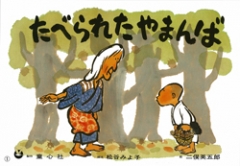
-
How the Witch was Eaten Up
Taberareta yamanba
Miyoko Matsutani , Eigoro Futamata / 16 sheets
This kamishibai retells the popular Japanese folktale Sanmai no fuda, or The Three Magic Charms. Miyoko Matsutani’s excellent text develops themes that run through the heart of many folktales: living life with spirit, the wisdom and strength to be found in common people. Eigoro Futamata’s illustrations deftly convey the atmosphere of the folktale and make expressive use of the kamishibai format. This work has come to represent folktale kamishibai both in Japan and abroad.
- ISBN978-4-494-07411-2
- ¥2,090E
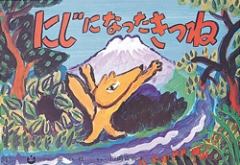
-
The Fox Who Became a Rainbow
Niji ni natta kitsune
Yuriko Kawada , Katsuji Fujita / 12 sheets
From time to time, folktales use animals to express and explore the meaning of human life. In this tale, the example of the fox Gorozaemon turning himself into a rainbow for the sake of an old man, expresses the wonderful, universal love that helps people summon their strength to help the weak. The charming final scene serves as inspiration to help others and live together in harmony.
- ISBN978-4-494-07476-1
- ¥1,760E
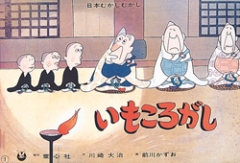
-
Tumbling Taros
Imo korogashi
Daiji Kawasaki, Kazuo Maekawa / 12 sheets
Japan’s many “priest and monk” folktales are said to have originated from a sense of resistance to authority. Daiji Kawasaki, who brilliantly evokes the spirit of common people in this story, showed a rebel spirit himself as the effective leader of postwar democratic cultural movements in Japan. He authored more than 140 kamishibai. Kazuo Maekawa’s comical illustrations add to the merriment.
- ISBN978-4-494-07504-1
- ¥1,760E
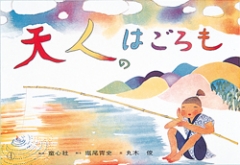
-
The Celestial Robe
Tennin no hagoromo
Horio Seishi , Toshi Maruki / 16 sheets
Hagoromo is a legend widely told throughout Japan, in which a heavenly lady comes to earth to retrieve her celestial robe. Writer Seishi Horio’s humanity makes this setting of the story particularly heartwarming. The impressively beautiful illustrations are the work of Toshi Maruki, known for the Hiroshima Murals. Her art for this kamishibai, first printed in 1961, capitalizes on special features of the format. A masterful retelling that could only have come to life as kamishibai.
- ISBN978-4-494-07593-5
- ¥2,090E
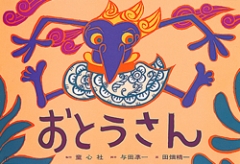
-
Father
Oto-san
Sumatran Folktale, Jun’ichi Yoda, Seiichi Tabata / 12 sheets
Seiichi Tabata’s superb illustrations for this work clearly show unique characteristics of visual expression possible in kamishibai. In addition, they convey the love shared between parent and child and impart a sense of sympathy for the lonely (in this case, the monster Mangalan Green Beku). Poet and children’s book author Jun’ichi Yoda wrote the text for a number of kamishibai and twice received the Gozan Prize (the highest annual distinction awarded for published kamishibai).
- ISBN978-4-494-07595-9
- ¥1,760E
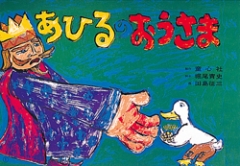
-
Duck the King
Ahiru no o-sama
French Folktale, Seishi Horio, Seizo Tashima / 12 sheets
This portrayal of a duck facing off with a tyrannical king shows the importance of standing up to the powerful. The spirit of resistance that runs through much French folklore meets illustrator Seizo Tashima’s long-held commitment to social issues. The impressive visual organization of the scenes and coloring of each sheet take advantage of the expressive possibilities of kamishibai. The text is rhythmical and easy to perform, making it a work that will stand the test of time.
- ISBN978-4-494-07597-3
- ¥1,760E
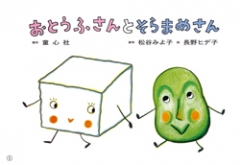
-
Tofu and Broad Bean
Otofu-san to soramame-san
Miyoko Matsutani, Hideko Nagano / 8 sheets
Why do broad beans have black lines in their skin? This folktale offers one explanation. The text by Miyoko Matsutani, who has produced a number of excellent kamishibai, tells the story in the sort of language that even young children can enjoy. Hideko Nagano’s warm and humorous illustrations showcase characters with a real sense of personality, evoking a world of spontaneity and fun.
- ISBN978-4-494-08970-3
- ¥1,540E
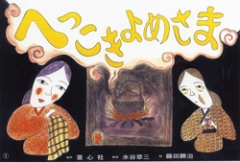
-
The Farting Young Wife
Hekkoki yome-sama
Shozo Mizutani, Katsuji Fujita / 12 sheets
This text by Shozo Mizutani, an author and longtime folktale researcher, warmly and affectionately tells the tale of Hekkoki yome, the farting bride. The kamishibai cheerfully and humorously conveys the strength to be found in everyday people. The energy that fuels the lives of ordinary Japanese is expressed with an original touch by Katsuji Fujita, effectively imparting courage to those who enjoy this kamishibai.
- ISBN978-4-494-08975-8
- ¥1,980E
